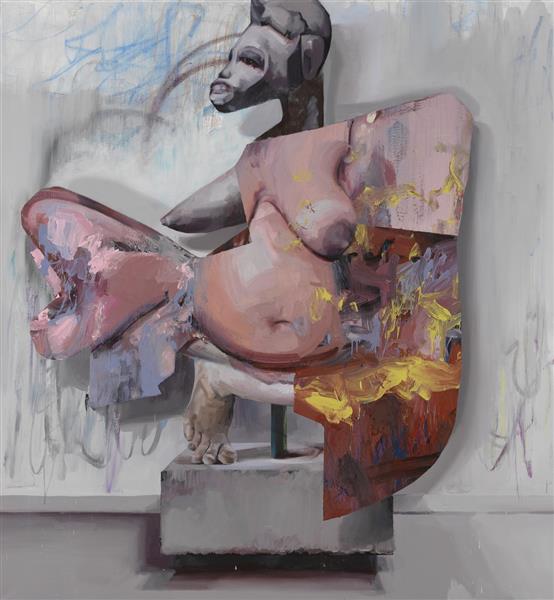Jenny Saville at Gagosian Gallery / New York
Originally published in Flash Art Issue 321 June – August 2018
I find myself reduced to a microscopical nobody thrust between the limbs that gawk out of Jenny Saville’s eleven large-scale canvases as part of her solo show “Ancestors” at Gagosian’s West 21st
location. While the limbs carry onwards from her past works, her move away from fluid strokes and anonymous beings and into static imagery — in one instance overarched with flamboyant gold — is perhaps her first foray away (albeit a hesitant, momentary one) from Willem De Kooning’s gaze. Literature on Saville portray her as a the Dutchman’s groupie — her devout admiration, revealed in a
2018 interview in Gagosian Quarterly, admittedly a little cultish — but “Ancestors” may be the first fork road away before she full-fledgedly snags the title of De Kooning’s successor. The series of works is based on classical sculpture figuratism layered into to Saville’s fleshy pastels wherein for the most part eyes of the figures look straight forward in sharp sterns instead of the absent expressions that haunt the artist’s earlier works; an enchanted potpourri of Hindu, Ancient Greek, Persian and Renaissance archetypes, of mythical fertility goddesses and Persian love narratives thrown about the gallery space offering minimal understanding of the service they perform beyond one that is
purely anatomical in a romantic rendering best servicing the Klimtians. Concurrently on view is a major survey of Jenny Saville at the Scottish National Gallery of Modern Art with works as early as 1992 that can hardly be pegged to the same artist. If her thematic explorations seem fleeting and random with little commitment to exhaustive exploration extending beyond the creases of human flesh then it might be that they are (but so be it). Anticipating what Saville will be whipping out next in monumental and utterly mastered painting skill is a thrilling aesthetic privilege that “Ancestors” delivers.
 | |||
| Fate 1, 2018 | Oil on canvas. Courtesy Gagosian New York. |
I find myself reduced to a microscopical nobody thrust between the limbs that gawk out of Jenny Saville’s eleven large-scale canvases as part of her solo show “Ancestors” at Gagosian’s West 21st
location. While the limbs carry onwards from her past works, her move away from fluid strokes and anonymous beings and into static imagery — in one instance overarched with flamboyant gold — is perhaps her first foray away (albeit a hesitant, momentary one) from Willem De Kooning’s gaze. Literature on Saville portray her as a the Dutchman’s groupie — her devout admiration, revealed in a
2018 interview in Gagosian Quarterly, admittedly a little cultish — but “Ancestors” may be the first fork road away before she full-fledgedly snags the title of De Kooning’s successor. The series of works is based on classical sculpture figuratism layered into to Saville’s fleshy pastels wherein for the most part eyes of the figures look straight forward in sharp sterns instead of the absent expressions that haunt the artist’s earlier works; an enchanted potpourri of Hindu, Ancient Greek, Persian and Renaissance archetypes, of mythical fertility goddesses and Persian love narratives thrown about the gallery space offering minimal understanding of the service they perform beyond one that is
purely anatomical in a romantic rendering best servicing the Klimtians. Concurrently on view is a major survey of Jenny Saville at the Scottish National Gallery of Modern Art with works as early as 1992 that can hardly be pegged to the same artist. If her thematic explorations seem fleeting and random with little commitment to exhaustive exploration extending beyond the creases of human flesh then it might be that they are (but so be it). Anticipating what Saville will be whipping out next in monumental and utterly mastered painting skill is a thrilling aesthetic privilege that “Ancestors” delivers.